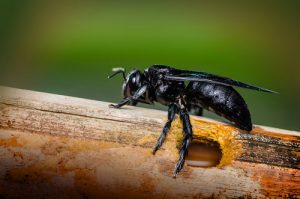What Caused Round Holes in Eaves?
By Chris Williams on December 19, 2011.
Q. My husband was painting the eaves on our house and found lots of round holes in the eaves on one side of the house. They’re totally circular and about the size of a dime, and they’re randomly spaced like they were made by some animal instead of an object. Do you think a woodpecker did this?
A. No, woodpecker holes in structures are irregularly shaped, not perfectly round. Because of the location, I think your husband found carpenter bee nest holes. Eaves, fascia boards and roof trim are favorite nest sites because the back side of the wood is often unpainted, something carpenter bees like. The bees usually attack bare or weathered wood without paint or stain. They prefer to nest in softwoods such as redwood, cedar, and pine. Outdoor decks and porches, cedar shingles, window sills, fence posts, and unfinished teak and other wooden deck furniture are other common nest sites.
In spring, the female carpenter bee chews into wood, excavating 6-8 brood cells, stocking each with a ball of pollen and a single egg. The nest opening begins on the flat face of the wood, then makes a right angle turn inside the wood to follow along the grain of the wood for several inches. A perfectly round, shirt-button-sized hole marks the entrance to the nest. The male carpenter bee stands guard outside the nest opening during the process. His size and loud buzzing is intimidating, but he can’t sting. The female carpenter bee can sting but she is not aggressive. If you think about it, you’ll probably remember seeing the large black and yellow bees around the outside of your home in late spring. Carpenter bees look like bumble bees except that their black abdomen is hairless, while bumble bees are fuzzy.
 Another clue that will tell you whether or not these are carpenter bee nest holes is the presence of yellow fecal stains on siding or surfaces below the nest hole opening. And if you were to split open one of the boards lengthwise, you would see the long nest tunnel separated off into several brood cells.
Another clue that will tell you whether or not these are carpenter bee nest holes is the presence of yellow fecal stains on siding or surfaces below the nest hole opening. And if you were to split open one of the boards lengthwise, you would see the long nest tunnel separated off into several brood cells.
Fortunately, carpenter bee damage is mostly cosmetic, not structural. However, damage can be serious when the bees nest in groups, or reinfest old nest sites the following year, or if woodpeckers attack the wood trying to reach the carpenter bee larvae inside. Since your husband found several holes, that indicates that carpenter bees have nested in the same site for several years and/or that more than one pair of bees have been nesting in the eaves.
The fact that your husband is painting the eaves should help reduce the number of nests next year since returning carpenter bees will find the painted wood less desirable. They will, however, sometimes still attack wood that has only a thin coating of paint, and even wood that has been lightly pressure-treated. If he can, your husband should seal the nest openings since often carpenter bees will reuse the same nests. And, tell him to be sure to paint the back sides of the eaves, too. If you see new carpenter bee nest holes next spring, give Colonial a call. We can treat the nest area and the nests themselves to prevent new bees from emerging in late summer.